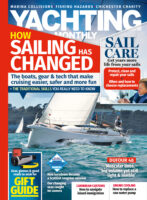Nic Compton finds out what makes the fast, forgiving Contessa 32 such an enduring classic, long famed for its windward performance and captivating sheerline
Contessa 32 review: Still an enduring classic
‘Once, we were going around Portland Bill in a blow and we hit a wave – the boat stopped and I carried on going. I flew 4ft through the air and landed on the other side of the cockpit. I was tied on, so I wasn’t in danger. But I thought, wow, that’s an eye-opener.’
This was a defining moment in Mike and Julie Sellers’ boat ownership – not of their beloved Contessa 32, which we are sitting on while Mike is speaking, but of their other boat, a J-97 cruiser/racer. The couple had owned their Contessa 32 L’Aquarelle for six years, when Mike started to have a yearning to race a faster boat. He and a friend bought the J-97 High Jinks together and had a fun time racing her for about three years, even competing in the 2019 Fastnet Race and finishing a respectable 17th out of 52 starters in their class.
Mike and Julie very nearly sold L’Aquarelle to fund this adventure, but Julie was so fond of the boat she persuaded Mike to only sell a 50% share in it instead, in order to reduce the maintenance bills. It was a wise decision as, after three years of high jinks, Mike had had his fill of racing modern yachts and decided to switch back to sailing the old Contessa full time. The experience off Portland Bill was one of the deciding factors. ‘The Contessa would never have done that,’ says Mike.
The couple duly sold their half-share in the J-97, bought back their half-share of L’Aquarelle, and life went back to normal. Or nearly. The bargain they had struck when they agreed not to sell the Contessa in the first place was that Julie would become her prime carer, as Mike didn’t think he could handle looking after two boats. Up until that point, he had been the person in charge of their boating life, both in running the boat and sailing it.
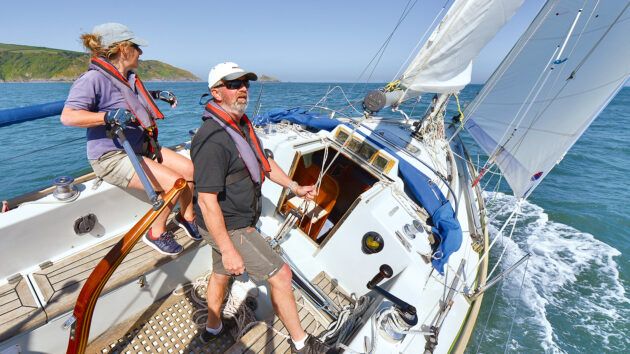
Julie persuaded Mike to buy back L’Aquarelle. Photo: Nic Compton
With the responsibility suddenly thrust upon her of looking after and sailing L’Aquarelle herself, Julie seized the challenge with both hands. She enrolled on several RYA courses, eventually completing her Day Skipper qualification as well as the Yachtmaster theory course.
To get more practical sailing experience, Julie joined the Ladies Afloat group at the Royal Dart Yacht Club, which organises women-only outings on dinghies and yachts, including day sails and overnight trips to nearby Salcombe and Brixham. The combined effect of these two initiatives (along with discovering an anti-nausea pill, called Cyclizine, that actually worked for her), transformed Julie’s experience of sailing.
Article continues below…
Heavy weather sailing: How and when to run for shelter
Previously we’ve looked at how to prepare your boat for heavy weather sailing, including how to rig and fit your…
Heavy weather sailing: How to prepare your yacht for a storm
From South Ocean pitchpolings to North Atlantic hurricanes, much has been written about the means and methods of heavy weather…
‘It completely changed my attitude,’ she explains. ‘Beforehand, I always felt like a passenger, just doing what I was told. Now I’m happy to take charge of a crew or even sail the boat on my own. It’s made life much easier for Mike, too, as we can share the responsibility, and he can sleep while I’m on watch knowing that the boat is in safe hands.’
In truth, there was never much doubt that Mike would end up owning a Contessa 32.
Brought up sailing from a young age, his parents’ first boat was a 26ft Westerly Centaur which they kept at Topsham on the River Exe, a one-hour drive from their home at Ilminster in Dorset. When Mike was a teenager, they switched to a Contessa 32, and the family never looked back.

A low coachroof is easy on the eye, but restricts the inside height to 5ft 10in. Photo: Nic Compton
Meanwhile, Mike pursued a career as an engineer, designing and making MRI scanners. He married Julie in 1992, and the couple travelled widely for his work, living in Germany and the United States. Their two sons were keen sailors, and by the time they got back to the UK in 2006 were competing in Optimists and then Lasers.
Both represented Team GB at a number of European events. Mike had a go racing RS500s and RS700s as well, but decided it wasn’t for him. Once the kids headed off to university, they decided the time had come to buy a yacht, and there was only one name on the list.
‘I didn’t look at any other boats,’ says Mike. ‘I only looked at Contessa 32s. It was the combination of racing, cruising with the association in the Solent, safety, affordability, and the prettiness of the boat that was convincing to me. It was a no-brainer. I looked at three Contessa 32s, and L’Aquarelle was the third one I viewed. She was in relatively good condition and had been owned by the secretary of the class association, who kept her for five years. She had a good story, and the price was right.’

L’Aquarelle was launched at the La Rochelle Boat Show in 1977. Photo: Nic Compton
The Contessa legend
Part of L’Aquarelle’s ‘good story’ was of course the story of the class, and how this modest 32-footer has developed an almost cult status. It started back in the mid-1960s when boatbuilder Jeremy Rogers, who had been building strip-planked Folkboats for years, decided to tweak the design (wider transom, higher sheer) and build them in fibreglass. The Folkboat Association was not amused so Jeremy decided to rename the new boat the Contessa 26 after co-designer David Sadler’s own boat, which was in turn a play on Sadler’s wife’s name, Tessa.
Jeremy built the Contessa 26 quite happily for several years before he finally agreed to build the bigger boat his clients had been clamouring for. This time he brought in Sadler from the start, and the pair came up with a pretty design that was neither modern nor old-fashioned, with a long fin keel and skeg rudder (unlike the long-keeled Contessa 26), encapsulated keel ballast, moderate overhangs, a reverse transom set on a short counter and an elegant sheerline.

The original tiller was restored rather than replaced in the refit. Photo: Nic Compton
Showered in accolades
The Contessa 32 was a success from the moment the first two boats were launched in 1971. Within weeks, Jeremy won his class at Cowes Week in his boat, Red Herring, and the following year the design was named Boat of the Year at the London Boat Show.
Sales quickly ballooned. In the first 10 years of production, some 500 boats were built and, by the time production ceased in 1983, around 600 boats had been built, not counting another 80 or 90 built in Canada mostly without permission. Since production resumed in 1995, sales have been a bit slower, but the Jeremy Rogers yard, now run by Kit and Jessie Rogers, still has a thriving business restoring old boats and building new ones.
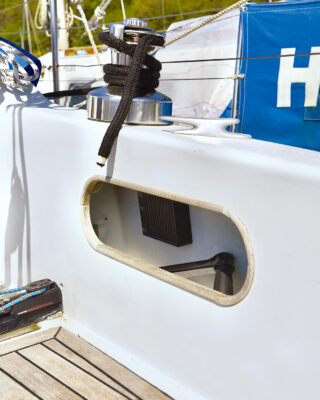
It’s nice to see proper cubby holes in the cockpit coamings. Photo: Nic Compton
The acclaim proved well deserved, as shown by numerous daring voyages made in Contessa 32s. But perhaps the Contessa 32’s finest hour came during the 1979 Fastnet Race. Out of 58 yachts that started in Class V, only one boat completed the course: Assent, a Contessa 32 owned by Willy Kerr and sailed by his son Alan.
In the official RYA inquiry on the disaster, the stability curve of the Contessa was used to illustrate the seaworthiness of long-keel designs compared to fin-keel designs such as the Half-Tonner. It was the start of the Contessa legend.
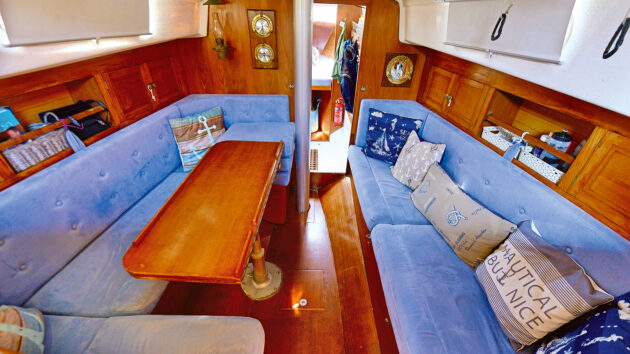
Solid-wood joinery has withstood the test of time well. The upholstery is new. Photo: Nic Compton
French boat show
L’Aquarelle was launched in 1977 in that first rush of excitement, when Jeremy’s yard had expanded capacity to five factories and 200 employees and was building an average of two boats per week. Originally called Jeff, she was exhibited at the La Rochelle Boat Show in 1977 and probably stayed in French waters for several years after that.
At some point she was renamed L’Aquarelle Verte (French for ‘green watercolour’) and was transported to Lake Geneva in Switzerland. There, she was spotted by the then C32 association secretary Keith Feltham, who brought her back to the UK through the French canals in 2005 and pared back her name to L’Aquarelle.
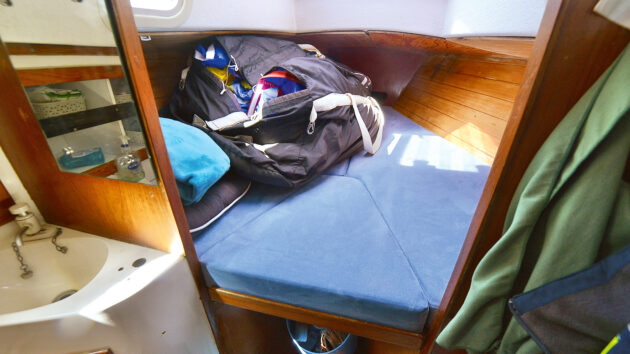
The forward cabin’s hatches let in plenty of light. Photo: Nic Compton
By the time Mike and Julie bought the boat in 2011, she was already 34 years old, though clearly well cared for. Since then, they’ve done the usual repairs and maintenance, including fitting new cushions, new sails, new sail covers, new standing rigging and new sprayhood.
Mike has also embarked on a process of ‘simplification’, getting rid of redundant or superfluous equipment. It started with the cold shower in the heads and the associated tank of cold water, then moved on to the music system (Julie’s dad made a mirror to cover the hole in the bulkhead left by one of the speakers). When I visited them in May, Mike had his eye on the anemometer on top of the mast which was malfunctioning.
‘I want to get rid of it,’ says Mike. ‘I don’t see the point in it; I can see what the wind is doing with my eyes. Think of all that useless weight up there, in the wrong place. The simpler the better. We have a chartplotter and navigation apps on our phones. We don’t need anything else. Do boats really need all those electronics?’
From 2012-20, Mike and Julie sailed L’Aquarelle on the Solent and became closely involved with the Contessa 32 association – Mike was the association secretary and then captain during the Covid pandemic and the class’s 50th anniversary celebrations.
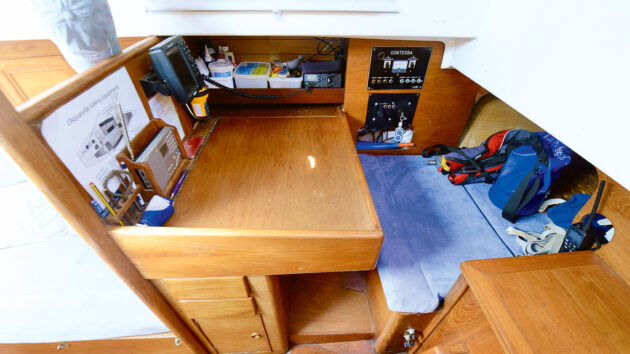
The chart table is comfortable and well set out with a pilot berth tucked into the starboard quarter. Photo: Nic Compton
Indeed, the class’s extensive racing schedule (the class has its own start at Cowes Week and in the Round the Island Race) and busy social programme are all part of the attraction.
Since moving to Dartmouth in 2020, the couple have visited the Channel Islands and the Isles of Scilly, and cruised along the north coast of France, going as far south as Lorient. They’ve competed in the Classic Channel Regatta, from Dartmouth to Paimpol, alongside big wooden classics. But their favourite area is Devon and Cornwall.
Gentle broacher
‘She’s a great cruiser racer, and because we don’t have lots of gear on board, she’s quite quick,’ says Mike. ‘She’s as quick or quicker than other new 32-footers, because they have so much volume and windage they don’t go to windward as well, though they do go quicker downwind. She is a quick boat when beating.’
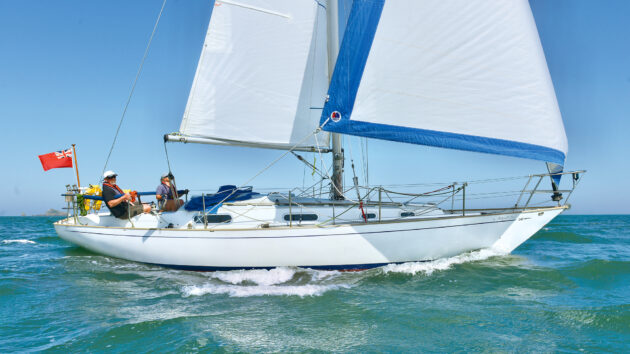
Mike and Julie regularly finish top three in their local races. Photo: Nic Compton
Then Mike introduced me to a new (to me) concept: the ‘gentle broacher’. ‘She’s a very gentle broacher,’ he says. ‘We’ve been out in some proper wind with the spinnaker up, and she’ll let you know ages before she’s going to broach. She just gradually goes, leans over, everything flaps around, then she comes back up and carries on sailing. Whereas with modern boats, it’s much more crash bang wallop, with people up to their waists in water.
The Contessa leans over but doesn’t go down as far, so the cockpit is always away from the water.’
Julie agrees. ‘I just feel very comfortable sailing her. I didn’t feel comfortable on the J-97. The cockpit was too flat and open with nothing to hold on to.
‘I like the safety of L’Aquarelle, the prettiness of her – and the fact that I can reach everything down below, despite the fact I’m only 5ft 2in!’
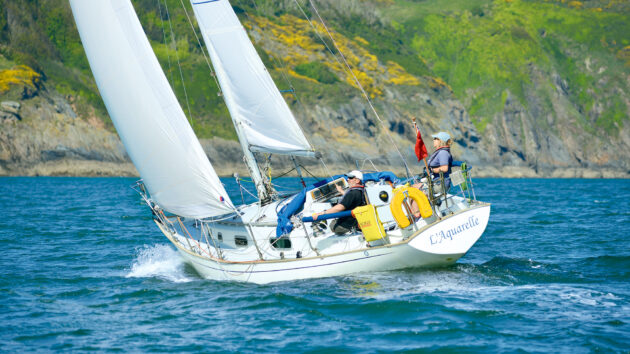
Julie joined the Ladies Afloat group at the Royal Dart Yacht Club to get more practical skippering experience. Photo: Nic Compton
It’s not all roses, however, and Mike and Julie do concede that L’Aquarelle is a wet boat – the price you pay for that good windward performance. She can also be rolly on a downwind run. ‘We call it the heave-ho,’ Mike says. ‘Once that starts going, there’s nothing you can do about it. You’ve just got to go with the boat, and she’ll eventually slow down and stop doing it.’
And there’s that old bugbear of most yachts of that era: the lack of space down below, including a mere 5ft 10in of headroom. ‘It’s ideal for two,’ says Mike. ‘It’s amazing to think they used to go racing with six blokes on board, and then wear ties and blazers to the club in the evening. They didn’t have furling headsails in those days either, so they had all the spare sails down below as well. Unbelievable.’
Contessa 32 specifications
DESIGNER: David Sadler
YEARS BUILT: 1971-present
LOA: 32ft / 9.75m
LWL: 24ft / 7.32m
BEAM: 9ft 6in / 2.9m
Draught: 5ft 6in / 1.68mm
DISPLACEMENT: 9,500 lbs / 4,309kg
BALLAST: 4,500 lbs / 2,041kg
SAIL AREA: 433 sq ft / 40.23m2
PRICE: £15,000-50,000
Enjoyed reading this?
A subscription to Yachting Monthly magazine costs around 40% less than the cover price, so you can save money compared to buying single issues.
Print and digital editions are available through Magazines Direct – where you can also find the latest deals.
YM is packed with information to help you get the most from your time on the water.
-
-
- Take your seamanship to the next level with tips, advice and skills from our experts
- Impartial in-depth reviews of the latest yachts and equipment
- Cruising guides to help you reach those dream destinations
-
Follow us on Facebook, Twitter and Instagram.
Note: We may earn a commission when you buy through links on our site, at no extra cost to you. This doesn’t affect our editorial independence.
Verdict
I joined Mike and Julie on L’Aquarelle on a bright and breezy day off Dartmouth. The wind was from the east, so the bay was reasonably sheltered inshore, with a long swell rolling as we headed further out to sea. As we tacked into the wind, L’Aquarelle lapped it up – though I was surprised at how tippy she was. It’s something that goes with the territory with these slippery hull shapes, which don’t have a lot of initial stability but then firm up once they get in their groove. It certainly didn’t seem to bother Mike and Julie, who took it all in their stride. Speedwise, the boat’s performance was pretty much as expected: good to windward (4.2 knots over the ground or 5.2 knots allowing for a foul tide) but slightly disappointing off the wind (approximately 6 knots over the ground or 5 knots allowing for tide) – especially compared to my Freedom 33 which tends to fly in these conditions. That said, there’s no doubt the Contessa points much higher, and I would much rather be beating to windward in heavy weather in L’Aquarelle than in my own boat. The proof of the sailing is in the racing, and there’s good reason Mike and Julie regularly finish in the top three in local races, including successes such as winning the RDYC Sailing Week and coming second in their class at the Dartmouth Regatta. The marketplace is another reliable indicator of a boat’s desirability, and there’s no doubt that second-hand Contessa 32s command a high price, suggesting the demand for this classic design shows absolutely no sign of waning. Not only that, but people are happily prepared to pay £350,000 plus VAT for this 54-year-old design to be built anew – surely the ultimate endorsement for any boat.

